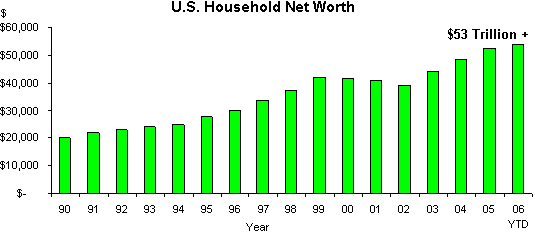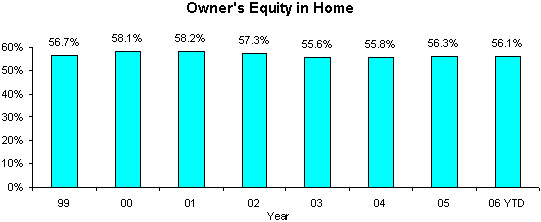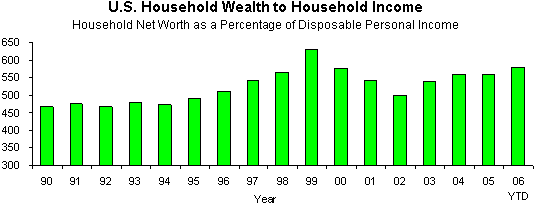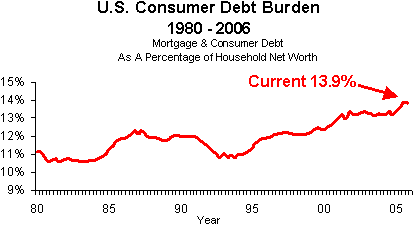IDEX Online Research: U.S. Household Debt Levels Still Manageable
June 25, 06
One of the most-watched economic measures in the
Debt Burden High, But Not Unmanageable
The consumer debt burden currently stands at 13.9 percent, a level it has maintained for the past couple of quarters. The debt burden is calculated by taking consumers’ mortgage and consumer debt (remaining balances due) and comparing it to total household net worth. While the debt burden appears high, it has been edging upward from about 11 percent over the past 25 years. In other words, there has been no sudden surge in consumers’ debt levels in recent periods.
The graph below illustrates the consumer debt burden of the typical American family.
|
|
Household Balance Sheets Very Strong
American consumers’ personal balance sheets are as strong as they have ever been. Three measures of consumer wealth – total net worth, owner’s home equity, and household income to household net worth – are either at record levels or are in solid territory.
Consumers’ total net worth reached over $53 trillion at the end of the first quarter, according to recently released statistics from the U.S. Federal Reserve Bank. After a pullback earlier in the decade which was related to the stock market decline, total household net worth has soared. In part, this is due to a recovery in the stock market; in part, this is due to sharply rising home prices.
The graph below summarizes consumer net worth trends in the

Source: Federal Reserve Bank
Home equity levels remain solid and very high. The Federal Reserve Bank measures owners’ equity as a percentage of the value of household real estate. This is the portion of the value of the home that consumers can claim on their personal balance sheet (the balance is owned by and owed to the bank which provided the home financing).
The graph below illustrates recent trends in home equity levels for

Source: Federal Reserve Bank
Finally, another key measure is household net worth to household income. This measure provides comfort to bankers and other lenders about the ability of consumers to service their debts. Again, this measure suffered as a result of the stock market correction at the beginning of the decade. However, in recent periods, household net worth has been building at a rapid rate. More importantly, household net worth has been rising at a faster rate than consumers have been taking on new debt. As a result, there appears to be both ample cash flow and solid asset security to back debt levels of the typical American household. The graph below summarizes recent trends in household net worth versus
household income.

Source: Federal Reserve Bank
